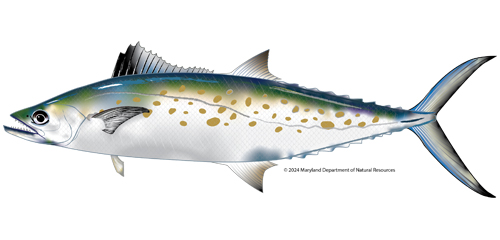| Spanish Mackerel |
 |
Spanish Mackerel |
| Scomberomorus maculatus |
(A.K.A. Atlantic Spanish mackerel, Mack)
|
Key Distinguishing Markings:
- The fish exhibits a green back
- Their sides are silvery marked with about three rows of round to elliptical yellow spots.
- Lateral line gradually curving down from the upper end of the gill cover toward caudal peduncle.
- The first (spiny) dorsal fin is black at the front.
- Posterior membranes are white with a black edge.
- A single row of cutting edged teeth in each jaw (around sixty-four teeth in all) are large, uniform, closely spaced and flattened from side to side, these teeth look very similar to those of the Bluefish.
View the Spanish Mackerel Gallery

|
Distribution:
- Spanish mackerel occur seasonally from the Yucatán peninsula, Mexico, as far north as Cape Cod, Massachusetts.
|
Size:
- Spanish mackerel mature by age-1 at a fork length (FL) of 14 inches (36 cm). Females live longer and grow to larger sizes than males. Females may live as long as 11 years, growing to 11 pounds (5.0 kg) and 33 inches (84 cm) FL. Males reach about age-6 and 19 inches (48 cm).
|
Habitat:
- They are a shallow water species, preferring sand bottom in depths of 10 to 40 feet (3 to 12 m), occasionally found as deep as 80 feet (24 m).
|
Spawning:
- The Gulf group of Spanish mackerel spawn in batches from May to September off shore of Texas, off the Gulf shore of Florida as early as April in some years.
- The Atlantic group spawns starting in April off the Carolinas and from late August to late September in the northernmost part of its range.
|
Fishing Tips:
- Recreational anglers catch Spanish mackerel from boats while trolling or drifting and from boats, piers, jetties, and beaches by casting spoons and jigs and live-bait fishing. Fast lure retrieves are key to catching these quick fish.
|
Fun Fact:
- Aerial spotting is sometimes used in locating this fish.
|
| Family: Scombridae (mackerels) |
| Order: Scombriformes (bony fish) |
| Class: Actinopterygii (ray-finned fishes) |
References
- Collette, B.; Boustany, A.; Carpenter, K.E.; et al. (2011). "Scomberomorus maculatus". The IUCN Red List of Threatened Species. 2011: e.T170323A6748550. doi:10.2305/IUCN.UK.2011-2.RLTS.T170323A6748550.en.
- "Scomberomorus maculatus". Integrated Taxonomic Information System. Retrieved 18 April 2006.
- Froese, Rainer and Pauly, Daniel, eds. (2006). "Scomberomorus maculatus" in FishBase. January 2006 version.
- "IGFA World Record; All Tackle Records; Mackerel, Spanish". IGFA World Records. International Game Fish Association. Retrieved 18 May 2016.
- Robert J. Goldstein (1 January 2000). Coastal Fishing in the Carolinas: From Surf, Pier, and Jetty. John F. Blair, Publisher. pp. 99–. ISBN 978-0-89587-195-4.
Illustration by Kevin Ensor, Maryland Department of Natural Resources, Fishing and Boating Services
|
